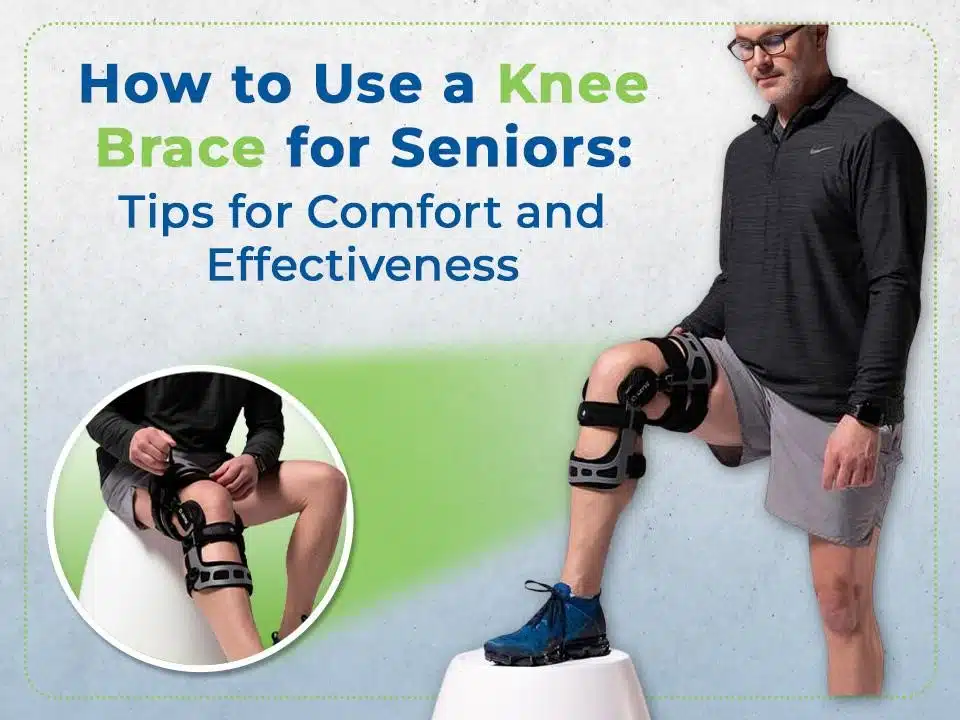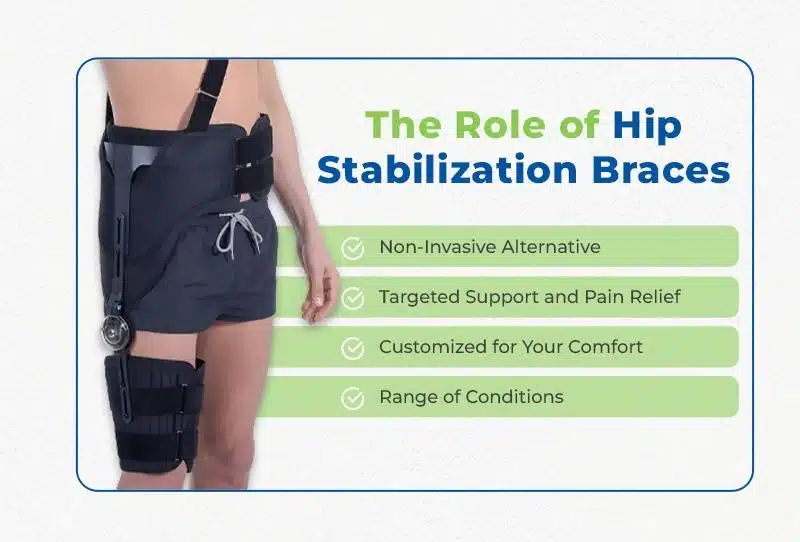Knee braces are valuable tools for seniors seeking to maintain mobility and manage knee pain effectively. These supportive devices can make a significant difference in the daily lives of older individuals. In this comprehensive guide, we will delve into the world of knee braces for seniors, offering valuable insights and practical tips to ensure seniors can maximize their knee braces’ comfort and effectiveness. Whether you’re a senior looking for relief from knee pain or a caregiver assisting a loved one, this guide will provide the knowledge and guidance needed to make the most of this essential orthopedic aid.
Understanding the Benefits of Knee Braces
Before delving into the practical aspects of using knee braces for seniors, it’s essential to understand the benefits these devices offer:
- Pain Relief: Knee braces provide targeted compression and support, alleviating pain and discomfort associated with various knee conditions. Whether it’s due to arthritis, osteoarthritis, or minor injuries, knee braces help manage pain effectively, allowing seniors to engage in daily activities with less discomfort.
- Stability: One of the primary benefits of knee braces is the enhanced stability they offer to the knee joint. Our muscles and ligaments may weaken as we age, making the knees more susceptible to instability. Knee braces are a reliable support system, reducing the risk of falls or injuries caused by knee joint instability. This added stability provides seniors with the confidence to move around more freely.
- Improved Mobility: Seniors often face mobility challenges due to knee pain or limited range of motion. Knee braces can significantly improve mobility and flexibility by reducing pain and discomfort. With proper support, seniors can regain their ability to walk, climb stairs, and engage in daily activities more comfortably, thus enhancing their overall quality of life.
- Posture Enhancement: Proper posture is crucial for joint health and overall well-being. Knee braces help by promoting correct alignment and reducing knee strain. When seniors wear knee braces, they are less likely to favor one knee over the other or develop poor posture habits that can exacerbate knee pain. This proactive approach to posture enhancement contributes to better long-term knee health.
Choosing the Right Knee Brace
Selecting the appropriate knee brace is essential for effective pain management and support. Here are some considerations for seniors:
- Consult a Healthcare Provider: Before making a choice, it’s advisable to seek guidance from a healthcare provider or orthopedic specialist. They can precisely assess your knee condition and recommend the type of knee brace that suits your needs. This professional insight ensures you select the most suitable brace for your condition.
- Comfort and Fit: Comfort is paramount when it comes to knee braces. Ensure the brace is comfortable for extended periods and fits properly to provide optimal support. A well-fitted knee brace offers better support and minimizes the risk of discomfort, skin irritation, or chafing. It should feel snug without being too tight.
- Adjustability: Look for knee braces with adjustable features. These braces allow you to customize the level of support according to your comfort and pain relief needs. The ability to fine-tune the fit and compression ensures that the brace remains effective as your knee condition evolves or changes.
- Material and Breathability: Consider the material of the knee brace. Opt for braces made of breathable materials that wick moisture away from the skin. Breathability prevents excessive sweating and irritation, especially during extended wear. A well-ventilated brace enhances overall comfort.
- Activity Level: When selecting a knee brace, consider your activity level and lifestyle. Some braces are designed for daily wear and provide continuous support for routine activities. Others are more specialized and cater to specific activities or recovery periods. Choose a knee brace that aligns with your lifestyle to ensure that it meets your unique requirements.
Putting on Your Knee Brace
Using a knee brace correctly is crucial for achieving the desired comfort and effectiveness. Here’s a step-by-step guide for seniors:
- Prepare the Brace: Before putting on your knee brace, take a moment to ensure that it’s clean and in good condition. Inspect the brace for any signs of wear and tear, such as loose straps or damaged components. A well-maintained brace functions better and provides the support you need.
- Sit Down: Find a comfortable chair or sit on the edge of your bed. A stable and comfortable seating position makes putting on your knee brace easier.
- Position Your Leg: Extend your leg slightly and position the knee brace over your knee joint. Ensure the brace is centered correctly over your kneecap and aligns with your leg’s natural contours. This proper positioning ensures optimal support and comfort.
- Secure Straps or Closures: Depending on the type of knee brace you have, it may feature straps, closures, or fasteners. Start fastening the straps or closures from the bottom of the brace and work your way up. Fasten them snugly but not too tight to avoid discomfort or circulation issues. Adjust the straps evenly to ensure uniform support around your knee.
- Check Comfort: After securing the knee brace, take a moment to check for comfort. Ensure the brace doesn’t cause irritation, pressure points, or rubbing against your skin. It should feel secure but not overly tight.
- Mobility Test: Stand up and test your mobility with the knee brace. Walk around and perform gentle knee movements to ensure that the brace provides the necessary support without restricting your movements excessively. Your knee should feel stable, and you should be able to move comfortably.
Daily Activities with a Knee Brace
Seniors can continue to lead active and fulfilling lives with the help of knee braces. These devices offer comfort, support, and improved mobility, making it easier to engage in daily activities. Here’s how seniors can seamlessly incorporate knee braces into their routines:
- Morning Routine: Start your day by putting on your knee brace. Ensure it is snug and comfortable before you begin your activities.
- Exercise and Physical Therapy: If your healthcare provider has recommended specific exercises or physical therapy, perform them while wearing your knee brace. The brace provides support and stability during these sessions, enhancing their effectiveness.
- Walking: Whether you’re taking a leisurely stroll around the neighborhood or a trip to the grocery store, your knee brace can offer added support. Make sure your brace is securely fastened before heading out.
- Stairs: When ascending or descending stairs, take one step at a time and hold onto the handrail if available. Your knee brace will provide support, but it’s essential to maintain balance and take precautions.
- Seated Activities: During activities that require sitting, such as reading, watching TV, or working at a desk, keep your knee brace on. This continuous support can help reduce strain on your knee joint.
- Rest and Elevation: If you experience fatigue or swelling in your knee, take breaks to rest and elevate your leg. Remove the brace temporarily, but ensure you wear it for movement activities.
- Nighttime Routine: Before bedtime, remove your knee brace and gently clean it as part of your nighttime routine. Ensure it’s completely dry before storing it.
Using a Knee Brace Correctly
To achieve the maximum comfort and effectiveness of your knee brace, it’s essential to use it correctly. Follow this step-by-step guide:
- Prepare the Brace: Ensure your knee brace is clean and in good condition before wearing it.
- Sit Down: Find a comfortable chair or sit on the edge of your bed.
- Position Your Leg: Extend your leg slightly and position the knee brace over your knee joint.
- Secure Straps or Closures: Depending on the type of knee brace, fasten the straps or closures to secure the brace in place. Start from the bottom and work up, ensuring a snug fit without overtightening.
- Check Comfort: Make sure the brace feels comfortable and doesn’t cause any irritation or pressure points.
- Mobility Test: Stand up and test your mobility with the knee brace. Ensure it provides the necessary support without restricting your movements excessively.
Caring for Your Knee Brace
Proper maintenance and care of your knee brace are essential for its longevity and effectiveness. Here are some tips:
- Regular Cleaning: Clean your knee brace regularly to prevent dirt, sweat, and bacteria buildup. Depending on the type of material, you can often hand wash the brace with mild soap and water. Rinse it thoroughly and let it air dry completely before wearing it again.
- Inspection: Periodically inspect your knee brace for any signs of wear and tear. Check the straps, closures, or any adjustable components to ensure they function correctly. If you notice any damage or issues, contact your healthcare provider or the manufacturer for guidance on repairs or replacements.
- Skin Protection: To prevent skin irritation or chafing caused by the brace, consider wearing a moisture-wicking undershirt or a thin, breathable layer of fabric between your skin and the brace. This can help reduce friction and keep your skin comfortable.
- Follow Instructions: Always follow the care instructions provided by the supplier or manufacturer of your knee brace. These instructions are specific to the materials and design of your brace and will help you maintain its performance and durability.
Read More: How Knee Braces Help Seniors Avoid Injury and Perform Better?
Conclusion
In conclusion, knee braces can be invaluable for seniors seeking comfort, support, and pain relief for their knees. By choosing the right knee brace, using it correctly, and providing proper care, seniors can enjoy improved mobility, reduced discomfort, and a better quality of life. These simple yet effective tools can make a significant difference in allowing older individuals to stay active, independent, and free from the limitations of knee pain. Whether for everyday activities or leisurely pursuits, a well-fitted knee brace can be a trusted companion on the journey to enhanced well-being and continued enjoyment of life’s pleasures.









